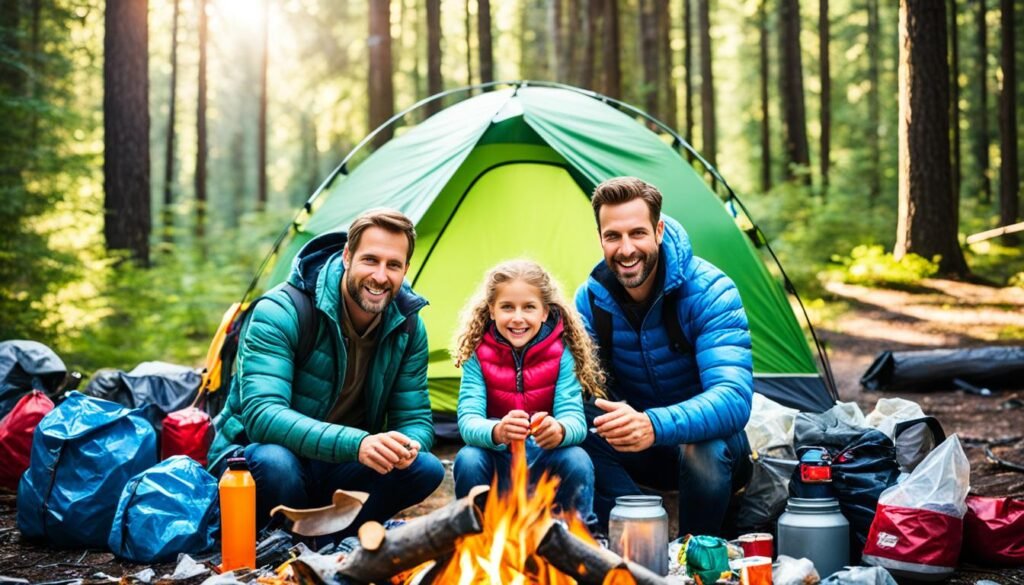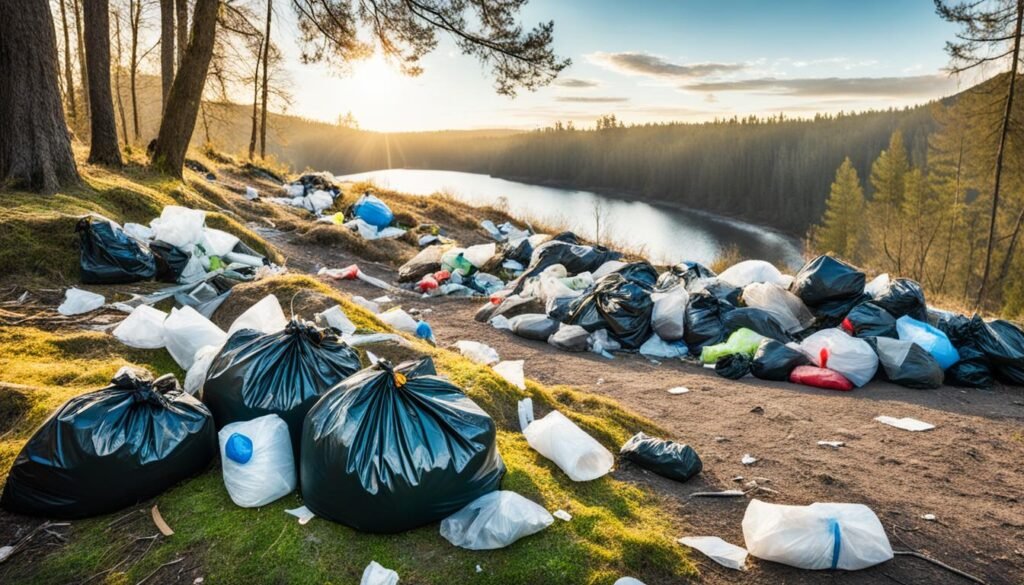Camping is a popular outdoor activity that allows people to enjoy nature and escape the hustle and bustle of everyday life. However, it is essential to understand the importance of cleaning up after camping to protect wildlife and preserve nature for future generations. Responsible camping involves leaving no trace behind and practicing ethical behavior to ensure the environment stays healthy and safe for everyone. By planning ahead, camping on durable surfaces, disposing of waste properly, respecting wildlife, being considerate of other visitors, and minimizing campfire impacts, campers can minimize their impact on the environment and contribute to the preservation of nature.
Key Takeaways:
- Responsible camping involves leaving no trace behind and practicing ethical behavior.
- Cleaning up after camping is crucial to protect wildlife and preserve nature.
- Plan ahead, camp on durable surfaces, and dispose of waste properly to minimize environmental impact.
- Respect nature, avoid disturbing natural structures, and leave artifacts in place.
- Minimize campfire impact to prevent accidental fires and preserve vegetation and wildlife.
Plan Ahead and Prepare
Planning and preparing for a camping trip is crucial for both the comfort and safety of campers and the preservation of the environment. By taking the time to plan ahead and prepare, you can minimize the environmental damage caused by your trip and ensure a smooth and enjoyable experience.
When it comes to camping trip planning, start by considering the capabilities of each participant and establishing goals for the trip. This will help you choose appropriate destinations and activities that align with the group’s abilities and interests. Researching the weather conditions and restrictions and regulations of the camping area is also important to ensure you are well-prepared for any challenges or limitations you may encounter.
Meal planning is another essential aspect of preparing for a camping trip. Creating a detailed meal and snack plan not only ensures that you have enough food for the duration of your trip, but also helps minimize waste. Pack lightweight and reusable food containers to reduce single-use plastic and opt for biodegradable soap for dishes to minimize the impact on the environment.

By planning ahead and being prepared, you can make the most of your camping trip while minimizing your environmental footprint. So take the time to research, plan, and pack accordingly, and enjoy a responsible and eco-friendly outdoor adventure.
Travel and Camp on Durable Surfaces
When venturing into the great outdoors, it is essential to understand the importance of camping on durable surfaces to minimize damage to the environment. By choosing durable surfaces such as sand, gravel, snow, and dry grasses, campers can avoid erosion and preserve the natural beauty of the area. Avoid setting up camp on easily damaged areas such as moist grass and vegetation, as this can lead to irreversible harm.
Sticking to designated trails is crucial to prevent further damage to the surrounding vegetation and wildlife habitats. These designated trails have been carefully crafted to minimize impact and provide safe passage through the wilderness. By adhering to the designated trails, campers can ensure the preservation of nature’s delicate balance.
Choosing established campsites is another way to reduce the environmental impact of camping. These sites have already gone through the necessary adaptations to minimize damage, such as the construction of fire rings and the clearing of vegetation. By utilizing established campsites, campers can rest easy knowing they are not contributing to the destruction of the environment.
Let’s take a look at the benefits of camping on durable surfaces and sticking to designated trails:
| Durable Surfaces | Benefits |
|---|---|
| Sand, Gravel, Snow, Dry Grasses | Minimizes erosion and damage to vegetation. |
| Moist Grass and Vegetation | Should be avoided due to their vulnerability to damage. |
Stick to Designated Trails
Designated trails are carefully crafted to minimize environmental impact and aid in the preservation of nature. By following these trails:
- Vegetation alongside the trails remains undisturbed.
- Wildlife habitats are protected.
- Erosion is reduced due to controlled foot traffic.
Choose Established Campsites
Established campsites have the following advantages:
- Fire rings are already present, minimizing the risk of damage caused by uncontrolled fires.
- Vegetation has been cleared, reducing the impact on plant life and preventing erosion.
- Facilities such as nearby bathrooms and waste disposal are available for campers to utilize responsibly.
By camping on durable surfaces, sticking to designated trails, and choosing established campsites, campers can minimize their impact on the environment and leave nature unspoiled for future generations to enjoy.
Dispose of Waste Properly
Proper waste disposal is essential to maintain the cleanliness of campsites and prevent environmental contamination. As responsible campers, we should follow the “pack it in, pack it out” principle, meaning we should carry out any trash we bring in and dispose of it in designated trash bins.
When it comes to wastewater disposal, it’s important to take extra precautions to minimize contamination. Whenever possible, campers should move at least 200 feet away from any water source before disposing of wastewater. Straining the water to remove food particles before disposal can further reduce the risk of contamination.
Moreover, solid human waste should be disposed of in catholes that are at least 200 feet away from water sources and campsites. To properly create a cathole, dig a hole that is approximately 6 to 8 inches deep, deposit the waste, cover the hole with soil, and pack it down to minimize any traces. By following this method, we can ensure that solid waste is disposed of in a way that leaves no trace behind and minimizes the risk of contaminating water sources.
Proper waste disposal is not only important for maintaining the beauty of the camping area but also for preventing the spread of disease. By disposing of waste properly, we can prevent littering, contamination of water sources, and potential health hazards.
Pack It In, Pack It Out Principle:
| Trash Item | Disposal Method |
|---|---|
| Plastic bottles and wrappers | Carry them out and dispose of them in designated trash bins. |
| Food packaging | Carry it out and dispose of it in designated trash bins. |
| Cigarette butts | Carry them out and dispose of them in designated trash bins. |
| Empty cans and bottles | Carry them out and dispose of them in designated trash bins. |
By adhering to the “pack it in, pack it out” principle and following proper waste disposal methods, we can ensure that our campsites remain clean, minimize contamination, and protect the natural environment for future generations.

Leave What You Find
Respecting nature and leaving what you find is crucial to preserve the beauty and integrity of natural environments. Campers should avoid disturbing or destroying natural structures such as rock formations, and should not remove artifacts or cut down trees. These natural structures provide habitat and food for wildlife and are part of the appeal of the camping area. By leaving natural structures and artifacts in place, campers can ensure that future visitors can also enjoy these natural wonders and preserve the habitat for wildlife.
Examples of Natural Structures to Respect and Preserve
| Natural Structure | Description |
|---|---|
| Rock Formations | Naturally occurring formations that add to the unique landscape |
| Tree Stumps | Decaying trees that serve as habitats and food sources for various creatures |
| Animal Burrows | Underground tunnels and dens used by animals for shelter |
Preserving these natural structures ensures the continuation of the ecosystem and allows other campers to appreciate the beauty of nature. By avoiding the disturbance or removal of such structures, campers play an active role in protecting wildlife habitats and preserving the natural wonders of their camping destinations.
Minimize Campfire Impact
Campfire management is crucial for responsible camping and minimizing the impact on the environment. To prevent accidental fires and preserve vegetation and wildlife, it is essential to follow proper campfire practices.
When setting up a campfire, it is best to use existing fire rings whenever possible. These designated areas help contain the fire and prevent it from spreading unintentionally. Additionally, creating small fires that are easy to control is important to minimize the risk of accidents and wildfires.
To fuel the campfire, gather small pieces of deadwood from areas away from the campsite instead of taking wood from living trees or fallen trees. This allows the natural environment to thrive and preserves the habitat for wildlife.
Furthermore, it is crucial to avoid burning trash and ensure that the ashes are thoroughly cooled before leaving the campsite. This prevents the spread of pollutants and reduces the risk of fire reignition. Remember, tents should never be located near fires to prevent accidents.
By practicing responsible campfire management, campers can enjoy the warmth and atmosphere of a campfire while protecting the surrounding vegetation, wildlife, and natural beauty. Let’s all do our part in preserving the environment for future generations to enjoy.
Does the Relaxing Nature of Camping Contribute to the Importance of Cleaning Up Afterwards?
The relaxing nature of camping is exactly why camping is relaxing. Being surrounded by nature can lower stress levels and promote a sense of calm. That’s why it’s crucial to clean up afterwards, to maintain the peaceful environment for others to enjoy.
FAQ
Why is it important to clean up after camping?
Cleaning up after camping is important to protect wildlife and preserve nature for future generations. It ensures that the environment stays healthy and safe for everyone to enjoy.
How can I plan ahead and prepare for a camping trip?
To plan ahead and prepare for a camping trip, consider the capabilities of each participant, establish goals for the trip, research and choose appropriate destinations, and take into account factors like weather conditions and group size. Create a meal and snack plan, pack lightweight and reusable food containers, and use biodegradable soap for dishes.
Why is it important to travel and camp on durable surfaces?
Traveling and camping on durable surfaces like sand, gravel, snow, and dry grasses minimizes damage to the environment. It helps to preserve vegetation, prevent erosion, and maintain the natural beauty of the area. Avoid camping on easily damaged areas like moist grass and vegetation.
How should I dispose of waste properly while camping?
Follow the “pack it in, pack it out” principle by carrying out any trash you bring in and disposing of it in designated bins. For wastewater, move at least 200 feet away from water sources, strain it to remove food particles, and then dispose of it. Solid human waste should be disposed of in catholes that are at least 200 feet away from water sources and campsites.
Why is it important to leave what you find while camping?
Respecting nature and leaving what you find helps to preserve the beauty and integrity of natural environments. Avoid disturbing or destroying natural structures like rock formations, artifacts, and cutting down trees. These structures provide habitat and food for wildlife and are part of the appeal of the camping area.
How can I minimize campfire impact while camping?
Practice responsible campfire management by using existing fire rings and only creating small fires that are easy to control. Gather small pieces of deadwood away from the campsite to start a fire instead of taking wood from trees or fallen trees. Avoid burning trash, and ensure that ashes are thoroughly cooled before leaving the campsite. Never locate tents near fires.







